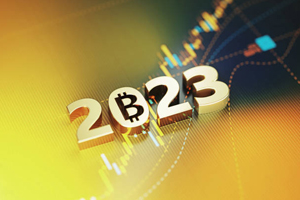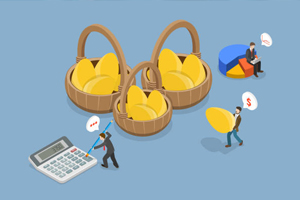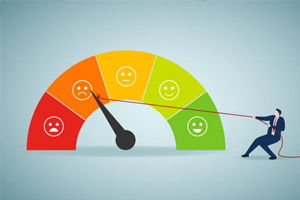Comparing interest rates on different types of loans
Unlock financing possibilities with our guide on securing personal loans with bad credit Explore strategies, overcome challenges, and make informed financial decisions
Welcome to our comprehensive guide on navigating the challenges of obtaining a personal loan with bad credit. In today's financial landscape, credit scores play a pivotal role in shaping borrowing opportunities, and individuals with less-than-ideal credit face unique considerations when seeking personal loans. This guide aims to shed light on the nuances of securing a personal loan with bad credit, offering insights into the impact of credit scores on loan terms, strategies for improvement, and navigating the lending landscape effectively.
Whether you're facing unexpected expenses, consolidating debt, or pursuing financial goals, understanding the dynamics of bad credit loans is crucial. We will explore the factors influencing eligibility, the relationship between credit scores and interest rates, and practical steps to enhance your chances of approval. Additionally, we'll delve into the potential challenges, such as higher interest rates and limited options, and provide guidance on avoiding predatory lending practices.
For those navigating the realm of personal finance with less-than-perfect credit, this guide serves as a valuable resource. We'll discuss the various types of personal loans available, explore the impact of credit history on loan terms, and offer actionable tips for building a more favorable financial profile over time. Empower yourself with knowledge as we unravel the intricacies of obtaining a personal loan with bad credit, providing you with the tools to make informed decisions and work towards financial well-being.
Join us on this journey through the world of bad credit loans, where we aim to equip you with the understanding and strategies needed to navigate the challenges and secure the best possible terms for your unique financial situation.

Factors Influencing Loan Interest Rates
1. Creditworthiness and Credit Scores
Explore how an individual's creditworthiness, often assessed through credit scores, plays a pivotal role in determining loan interest rates. Understand the impact of credit history, payment behavior, and overall financial responsibility on securing favorable rates.
2. Economic Conditions and Market Trends
Examine the broader economic landscape and how it influences loan interest rates. Factors such as inflation rates, unemployment levels, and central bank policies contribute to market trends. Understand how these conditions affect the cost of borrowing.
3. Loan Term and Type
Delve into how the term and type of the loan influence interest rates. Shorter-term loans may come with lower interest rates but higher monthly payments, while longer-term loans may have higher overall interest costs. Additionally, secured loans often offer lower rates compared to unsecured loans.
4. Lender Policies and Risk Assessment
Understand how individual lenders' policies and risk assessments impact the interest rates they offer. Lenders evaluate the risk associated with each borrower based on factors such as income stability, employment history, and debt-to-income ratio. Learn how to navigate lender-specific criteria for securing better rates.
5. Market Competition and Loan Pricing
Explore the role of market competition in shaping loan interest rates. Understand how lenders compete for borrowers, leading to variations in pricing. Analyze how shopping around and comparing offers can empower borrowers to secure more competitive rates.
6. Borrower's Financial Profile
Examine the comprehensive financial profile of borrowers, including income, debt levels, and existing financial obligations. Lenders assess this profile to determine the borrower's ability to repay the loan. Discover strategies to strengthen your financial profile for improved interest rate outcomes.
7. Inflation and Interest Rate Risk
Understand the impact of inflation on interest rates and the associated interest rate risk. Inflation erodes the purchasing power of money over time, influencing lenders to adjust interest rates. Explore how borrowers can navigate inflationary trends and mitigate interest rate risk.
8. Credit Union and Online Lender Dynamics
Explore the dynamics of obtaining loans from credit unions and online lenders. Credit unions, as nonprofit organizations, may offer more favorable rates to members. Online lenders leverage technology for streamlined processes and may provide competitive rates. Learn about the advantages and considerations of these lending sources.
9. Government Influence on Interest Rates
Examine how government policies and interventions influence interest rates. Central banks may implement monetary policies that impact the overall interest rate environment. Understand the cascading effects of government actions on borrowing costs.
10. Relationship Between Interest Rates and Fees
Explore the relationship between interest rates and additional fees associated with loans. Some lenders may offer lower interest rates but impose higher fees. Understand how to evaluate the overall cost of borrowing by considering both interest rates and associated fees.
Comparing Fixed and Variable Interest Rates
1. Understanding Fixed Interest Rates
Explore the concept of fixed interest rates, where the interest rate remains constant throughout the loan term. Learn about the stability and predictability offered by fixed rates, making them suitable for budgeting and long-term financial planning.
2. Pros and Cons of Fixed Rates
Examine the advantages and disadvantages of opting for fixed interest rates. While fixed rates provide stability, they may be higher initially than variable rates. Understand how fixed rates protect borrowers from market fluctuations but may limit potential savings during periods of falling interest rates.
3. Dynamics of Variable Interest Rates
Dive into the dynamics of variable interest rates, where the rate fluctuates based on changes in market conditions. Understand the factors, such as economic indicators and central bank decisions, that influence the variability of these rates.
4. Pros and Cons of Variable Rates
Explore the benefits and drawbacks associated with variable interest rates. Variable rates may start lower than fixed rates, offering potential cost savings. However, they introduce uncertainty as payments can increase or decrease with market fluctuations. Learn how to assess risk tolerance and financial goals when considering variable rates.
5. Interest Rate Caps and Limits
Understand the concept of interest rate caps and limits in variable rate loans. Explore how lenders may implement caps to protect borrowers from extreme interest rate increases. Learn about periodic and lifetime caps and their impact on payment fluctuations.
6. Choosing Between Fixed and Variable Rates
Explore the decision-making process when choosing between fixed and variable interest rates. Consider individual financial goals, risk tolerance, and market expectations. Understand how economic conditions and interest rate forecasts can inform the choice between the stability of fixed rates and the potential savings of variable rates.
7. Hybrid or Combination Loans
Examine hybrid or combination loans that offer a mix of fixed and variable interest rates. Understand how these loans provide a middle-ground option, allowing borrowers to benefit from both stability and potential cost savings. Learn about the specific terms and adjustments in hybrid loan structures.
8. Impact of Economic Factors on Variable Rates
Delve into the impact of economic factors, such as inflation, employment rates, and monetary policies, on variable interest rates. Understand how changes in these factors influence the direction and magnitude of variable rates. Stay informed about economic indicators to anticipate potential rate adjustments.
9. Historical Performance of Fixed vs. Variable Rates
Explore the historical performance of fixed and variable interest rates. Analyze how these rates have behaved in different economic environments. Understanding historical trends can provide insights into potential future movements and aid in decision-making.
10. Refinancing Strategies for Rate Optimization
Learn about refinancing strategies to optimize interest rates over time. Understand how refinancing can be used to switch between fixed and variable rates based on changing financial circumstances and market conditions. Explore the potential benefits and considerations of refinancing loans.
Exploring Mortgage Loan Interest Rates
1. Impact of Credit Score on Mortgage Rates
Understand how credit scores influence mortgage loan interest rates. Explore the credit score ranges and the relationship between creditworthiness and the cost of borrowing for a home. Discover strategies to improve credit scores for better mortgage rates.
2. Fixed vs. Adjustable-Rate Mortgages (ARMs)
Explore the differences between fixed-rate and adjustable-rate mortgages (ARMs). Understand how fixed-rate mortgages offer stable interest rates throughout the loan term, while ARMs may start with lower rates that can adjust periodically. Evaluate the pros and cons of each option based on financial goals and risk tolerance.
3. Down Payments and Interest Rates
Delve into the relationship between down payments and mortgage interest rates. Understand how larger down payments can lead to lower interest rates and potentially save money over the life of the loan. Explore down payment requirements and their impact on overall loan costs.
4. Loan Term and Its Effect on Interest Rates
Explore how the term of the mortgage loan affects interest rates. Understand the trade-offs between shorter-term loans with higher monthly payments but lower overall interest costs and longer-term loans with lower monthly payments but higher total interest expenses. Consider the impact of loan term on financial goals and affordability.
5. Government-Backed Mortgages and Interest Rates
Understand the role of government-backed mortgages, such as FHA, VA, and USDA loans, in relation to interest rates. Explore how these programs impact eligibility criteria and interest rate structures. Assess the suitability of government-backed options based on individual circumstances.
6. Private Mortgage Insurance (PMI) and Interest Rates
Examine the connection between private mortgage insurance (PMI) and interest rates. Understand how borrowers with lower down payments may be required to pay for PMI, affecting the overall cost of homeownership. Learn strategies to manage PMI costs and explore loan options that mitigate the need for PMI.
7. Market Conditions and Mortgage Rates
Explore how broader market conditions, including economic indicators and central bank policies, impact mortgage interest rates. Understand the cyclical nature of mortgage rates and how external factors can influence borrowing costs for homebuyers. Stay informed about market trends when considering a home purchase.
8. Closing Costs and Interest Rate Considerations
Understand how closing costs contribute to the overall cost of a mortgage. Explore the relationship between closing costs and interest rates, and how lenders may offer different combinations of rates and fees. Learn about strategies to negotiate closing costs and secure favorable loan terms.
9. Refinancing Opportunities and Strategies
Explore opportunities for mortgage refinancing and the strategies involved. Understand how refinancing can be used to lower interest rates, change loan terms, or tap into home equity. Evaluate the timing and considerations for refinancing in response to changing market conditions.
10. Jumbo Loans and Their Unique Interest Rate Dynamics
Delve into the unique dynamics of jumbo loans and their impact on interest rates. Understand how jumbo loans, which exceed conventional loan limits, may come with different eligibility criteria and interest rate structures. Explore considerations for borrowers seeking higher loan amounts.
Auto Loan Interest Rates: Secured vs. Unsecured
1. Secured Auto Loans and Interest Rates
Explore the concept of secured auto loans and their impact on interest rates. Secured loans are backed by collateral, often the vehicle itself, which can result in lower interest rates. Understand the risk and benefits associated with securing an auto loan.
2. Collateral and Loan-to-Value Ratio
Examine the role of collateral in determining auto loan interest rates. Understand how lenders assess the loan-to-value (LTV) ratio, comparing the loan amount to the vehicle's value. Learn how a lower LTV ratio can contribute to lower interest rates.
3. Unsecured Auto Loans and Interest Rates
Dive into the dynamics of unsecured auto loans and their impact on interest rates. Unsecured loans do not require collateral, leading to higher interest rates. Explore the trade-offs and considerations when opting for an unsecured auto loan.
4. Credit Scores and Auto Loan Interest Rates
Understand the relationship between credit scores and auto loan interest rates. Explore how individuals with higher credit scores generally qualify for lower interest rates. Discover strategies to improve credit scores before applying for an auto loan.
5. Down Payments and Interest Rates
Delve into the impact of down payments on auto loan interest rates. Understand how larger down payments can result in lower interest rates, potentially saving money over the life of the loan. Explore down payment requirements and their connection to overall loan costs.
6. Loan Term and Monthly Payments
Explore how the term of the auto loan influences interest rates and monthly payments. Understand the trade-offs between shorter-term loans with higher monthly payments but lower overall interest costs and longer-term loans with lower monthly payments but higher total interest expenses.
7. Dealer Financing vs. Direct Lenders
Examine the differences between dealer financing and obtaining auto loans from direct lenders. Understand how dealer financing may offer convenience but could result in higher interest rates. Explore the advantages and considerations of securing auto loans directly from lenders.
8. Preapproval and Its Impact on Interest Rates
Understand how obtaining preapproval for an auto loan can impact interest rates. Explore the advantages of preapproval, including the ability to negotiate interest rates with confidence. Learn how preapproval can streamline the car-buying process.
9. Refinancing Auto Loans for Better Rates
Explore opportunities for refinancing auto loans to secure better interest rates. Understand the considerations, including improvements in credit scores or changes in market conditions, that may warrant exploring refinancing options. Evaluate the potential benefits and challenges of refinancing.
10. Balloon Payments and Their Influence on Interest Rates
Delve into the concept of balloon payments and their influence on auto loan interest rates. Understand how balloon payments, larger lump-sum payments due at the end of the loan term, can impact the overall cost of the loan. Explore considerations for borrowers when faced with balloon payment options.
Personal Loans: Unveiling Interest Rate Dynamics
1. Credit Scores and Personal Loan Interest Rates
Explore the relationship between credit scores and personal loan interest rates. Understand how individuals with higher credit scores generally qualify for lower interest rates. Discover strategies to improve credit scores before applying for a personal loan.
2. Unsecured Nature and Interest Rate Variability
Dive into the unsecured nature of personal loans and how it contributes to interest rate variability. Unlike secured loans, personal loans don't require collateral, resulting in potentially higher interest rates. Understand the trade-offs and considerations associated with unsecured personal loans.
3. Loan Amount and Interest Rate Considerations
Examine how the loan amount influences personal loan interest rates. Understand the concept of risk-based pricing, where larger loan amounts may lead to higher interest rates. Explore considerations for borrowers in determining the appropriate loan amount based on their financial needs.
4. Debt-to-Income Ratio and Interest Rates
Understand the impact of the debt-to-income (DTI) ratio on personal loan interest rates. Lenders assess the DTI ratio to evaluate a borrower's ability to manage additional debt. Explore how a lower DTI ratio can contribute to lower interest rates and improve loan approval chances.
5. Fixed vs. Variable Interest Rates for Personal Loans
Explore the choice between fixed and variable interest rates for personal loans. Understand how fixed rates offer stability with constant payments, while variable rates may fluctuate based on market conditions. Evaluate the pros and cons of each option based on financial goals and risk tolerance.
6. Loan Term and Its Impact on Interest Rates
Delve into how the term of the personal loan impacts interest rates. Understand the trade-offs between shorter-term loans with higher monthly payments but lower overall interest costs and longer-term loans with lower monthly payments but higher total interest expenses. Consider the impact of loan term on financial goals and affordability.
7. Online Lenders and Competitive Interest Rates
Examine the role of online lenders in providing competitive interest rates for personal loans. Understand how online lending platforms leverage technology to streamline processes and reduce overhead costs, potentially offering more favorable rates. Explore the advantages and considerations of obtaining personal loans from online lenders.
8. Relationship Between Interest Rates and Fees
Explore the relationship between interest rates and additional fees associated with personal loans. Some lenders may offer lower interest rates but impose higher fees. Understand how to evaluate the overall cost of borrowing by considering both interest rates and associated fees.
9. Co-Signers and Their Influence on Interest Rates
Understand how co-signers can influence personal loan interest rates. Co-signers with strong credit profiles may help secure lower rates for the primary borrower. Explore the considerations and responsibilities associated with co-signing a personal loan.
10. Repayment Strategies for Managing Interest Costs
Explore repayment strategies to effectively manage interest costs on personal loans. Understand how making additional payments, consolidating debt, or refinancing can impact the overall interest paid. Learn about proactive approaches to minimize interest expenses and achieve financial goals.
Student Loans: Navigating Interest Rate Variations
1. Federal Student Loans and Fixed Interest Rates
Explore federal student loans and the prevalence of fixed interest rates. Understand how fixed rates offer stability throughout the life of the loan. Learn about the types of federal student loans and the associated fixed interest rate structures.
2. Private Student Loans and Variable Interest Rates
Dive into the dynamics of private student loans, often featuring variable interest rates. Understand how variable rates can fluctuate based on market conditions. Explore the trade-offs and considerations when opting for private student loans with variable interest rates.
3. Credit Scores and Its Impact on Student Loan Rates
Examine the role of credit scores in determining student loan interest rates, especially in the context of private student loans. Understand how a strong credit profile may result in lower interest rates and better loan terms. Explore strategies to improve credit scores for favorable student loan rates.
4. Subsidized vs. Unsubsidized Federal Loans
Explore the distinctions between subsidized and unsubsidized federal student loans and their impact on interest rates. Understand how subsidized loans offer interest relief during certain periods, while interest accrues on unsubsidized loans. Consider the implications for managing overall loan costs.
5. Graduated and Income-Driven Repayment Plans
Delve into repayment plans and their connection to interest rates. Understand how graduated repayment plans and income-driven repayment plans may influence the total interest paid over the life of the loan. Explore the flexibility these plans offer in managing student loan debt.
6. Loan Consolidation and Its Effect on Interest Rates
Explore the option of loan consolidation and how it impacts student loan interest rates. Understand the potential benefits and drawbacks of consolidating federal student loans into a Direct Consolidation Loan, including its influence on interest rates and repayment terms.
7. Impact of Loan Fees on Overall Borrowing Costs
Understand how loan fees contribute to the overall cost of student loans. Explore the fees associated with federal and private student loans and their impact on the effective interest rate. Learn how to factor in these fees when comparing loan options.
8. Refinancing Student Loans for Better Rates
Explore opportunities for refinancing student loans to secure better interest rates. Understand the considerations, including improvements in credit scores or changes in market conditions, that may warrant exploring refinancing options. Evaluate the potential benefits and challenges of refinancing student loans.
9. Public Service Loan Forgiveness and Interest Rates
Examine the connection between public service loan forgiveness programs and interest rates. Understand how participating in these programs may impact the overall repayment strategy and the total interest paid on qualifying federal student loans.
10. Financial Literacy and Smart Borrowing Practices
Explore the importance of financial literacy in making informed borrowing decisions for student loans. Understand smart borrowing practices, including budgeting, researching loan terms, and exploring scholarship and grant opportunities. Learn how financial literacy can empower students to navigate interest rate variations effectively.
Interest Rates on Credit Cards: The Fine Print
1. Annual Percentage Rate (APR) and Its Components
Explore the concept of Annual Percentage Rate (APR) on credit cards. Understand how APR represents the total cost of borrowing, including interest and fees. Break down the components of APR, including the nominal interest rate, annual fees, and other charges.
2. Fixed vs. Variable APR
Dive into the distinction between fixed and variable APR on credit cards. Understand how fixed rates remain constant, providing predictability, while variable rates may fluctuate based on market conditions. Explore the pros and cons of each type of APR and considerations for cardholders.
3. Introductory APR Offers and Their Terms
Examine introductory APR offers on credit cards and the associated terms. Understand how credit card issuers may offer low or 0% APR for a promotional period. Explore the conditions, such as balance transfer fees and time limitations, attached to these introductory offers.
4. Penalty APR and Its Triggers
Explore penalty APR and the circumstances that trigger its application. Understand how late payments or other default events may result in a higher penalty APR. Learn about the implications of penalty APR on overall credit card costs and strategies to avoid triggering it.
5. Grace Periods and Interest-Free Days
Delve into the concept of grace periods and interest-free days on credit cards. Understand how cardholders can avoid interest charges by paying the full balance within the grace period. Explore the variations in grace periods among different credit cards and their impact on interest costs.
6. Foreign Transaction Fees and Currency Conversion
Explore the impact of foreign transaction fees on credit card costs. Understand how credit card issuers may charge fees for transactions made in foreign currencies. Learn about currency conversion rates and considerations for international card use.
7. Cash Advance APR and Fees
Understand the dynamics of cash advance APR on credit cards. Explore how cash advances may have higher APRs and associated fees. Learn about the implications of using credit cards for cash withdrawals and strategies to minimize associated costs.
8. Balance Transfer APR and Considerations
Examine balance transfer APR on credit cards and the considerations involved. Understand how cardholders may transfer balances from one card to another to take advantage of lower APRs. Explore balance transfer fees, introductory APR offers, and strategies for effective balance transfers.
9. Credit Card Tier Systems and Interest Rates
Explore credit card tier systems and how they impact interest rates. Understand how premium or reward cards may have different APR structures compared to standard cards. Learn about the factors that contribute to tiered interest rates on credit cards.
10. Credit Card Terms and Conditions Review
Highlight the importance of reviewing credit card terms and conditions, especially regarding interest rates. Encourage cardholders to read the fine print to understand all aspects of the APR, fees, and other relevant terms. Provide guidance on making informed decisions based on the disclosed details.
Effect of Credit Scores on Loan Interest Rates
1. Understanding Credit Scores and Their Significance
Explore the concept of credit scores and their importance in the lending industry. Understand how credit scores serve as a numerical representation of an individual's creditworthiness. Discuss the range of credit scores and their impact on loan eligibility and interest rates.
2. Excellent Credit Scores and Favorable Interest Rates
Dive into the benefits of having an excellent credit score in relation to loan interest rates. Discuss how individuals with high credit scores typically qualify for lower interest rates. Explore the advantages of maintaining an excellent credit profile and its impact on borrowing costs.
3. Good Credit Scores and Competitive Loan Terms
Examine the relationship between good credit scores and competitive loan terms. Discuss how individuals with good credit scores may still qualify for favorable interest rates and loan terms. Explore the range of credit scores considered as "good" and their implications for borrowing.
4. Average Credit Scores and Interest Rate Challenges
Explore the challenges faced by individuals with average credit scores when it comes to securing favorable interest rates. Discuss how borrowers with average credit may encounter higher interest rates and explore strategies to improve credit profiles for better loan terms.
5. Poor Credit Scores and Impact on Loan Eligibility
Delve into the impact of poor credit scores on loan eligibility and interest rates. Discuss the challenges individuals with poor credit face when seeking loans. Explore alternative lending options, such as secured loans, for those with lower credit scores.
6. Credit Score Ranges and Lender Criteria
Examine the different credit score ranges and how lenders assess borrower eligibility. Discuss the criteria lenders use to categorize credit scores and the corresponding interest rate structures. Explore the nuances of lender policies based on credit score ranges.
7. Role of Credit Bureaus in Determining Credit Scores
Explore the role of credit bureaus in determining credit scores. Discuss how credit bureaus collect and evaluate financial information to generate credit scores. Highlight the importance of monitoring credit reports for accuracy and addressing errors that may impact credit scores.
8. Credit Score Factors Beyond Payment History
Discuss factors beyond payment history that influence credit scores. Explore the impact of credit utilization, length of credit history, types of credit, and new credit on overall credit scores. Provide insights into how individuals can strategically manage these factors to improve credit profiles.
9. Strategies for Improving Credit Scores
Offer practical strategies for improving credit scores. Discuss responsible credit management, timely payments, and debt reduction techniques. Provide guidance on obtaining and reviewing credit reports, identifying areas for improvement, and building a positive credit history.
10. Importance of Shopping Around for Loan Offers
Highlight the importance of shopping around for loan offers based on credit scores. Discuss how different lenders may offer varying interest rates for the same credit profile. Encourage borrowers to compare loan terms, negotiate with lenders, and choose the most favorable options based on their credit scores.
FAQs about Qualifying for a Personal Loan with Bad Credit
Q1: Can I qualify for a personal loan with bad credit?
A1: Yes, it's possible to qualify for a personal loan with bad credit. However, individuals with lower credit scores may face challenges such as higher interest rates and stricter eligibility criteria. Exploring lenders specializing in bad credit loans or considering secured personal loans could be viable options.
Q2: How does bad credit impact the interest rates on personal loans?
A2: Bad credit can significantly impact the interest rates on personal loans. Lenders may view individuals with lower credit scores as higher-risk borrowers, resulting in higher interest rates. It's important to carefully review and compare loan offers, considering both the interest rates and associated fees.
Q3: Are there specific strategies to improve my chances of approval with bad credit?
A3: Yes, there are strategies to improve your chances of approval. Consider providing collateral for a secured personal loan, exploring lenders specializing in bad credit, and demonstrating a stable income and employment history. Additionally, working on improving your credit score over time can enhance your eligibility for better loan terms.
Q4: Can I refinance a personal loan to get better terms with bad credit?
A4: Refinancing a personal loan to get better terms with bad credit may be challenging. Lenders typically consider your creditworthiness when offering refinancing options. However, as you work on improving your credit score, you may become eligible for refinancing opportunities in the future.
Q5: How can I avoid predatory lenders when seeking a personal loan with bad credit?
A5: To avoid predatory lenders, carefully research and choose reputable lenders. Be cautious of lenders offering guaranteed approval or asking for upfront fees. Review the terms and conditions, including interest rates and fees, and compare offers from multiple lenders to make an informed decision.




























